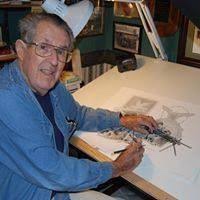
Artist Dick Kramer passed away late last week. He was well known for his pencil drawings of military, law enforcement and first responders.
He will be missed. May He Rest In Peace.

Artist Dick Kramer passed away late last week. He was well known for his pencil drawings of military, law enforcement and first responders.
He will be missed. May He Rest In Peace.
Growing up the movie “Attack Force Z” one of my favorite movies and still is. I have always wanted to an old school WW2 operation doing an insert by Klepper kayaks and blow-up a ship in a harbor or a bridge. You know like Cockleshell heroes or Attack Force Z
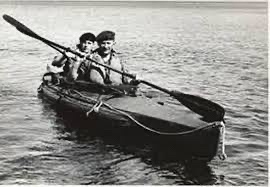
SOE-Australia (SOA) was a WWII Special Forces and covert operations organization operating in the Pacific theater behind Japanese lines. It was made up of men and women from Australian, British, New Zealand, Canadian, South African, Indonesian, Timorese and Malay. SOA fought a secret, undercover war against the Japanese occupying force on the islands north of Australia. With the success of the British SOE unit in the European theater, Winston Churchill ordered that a similar unit be formed in the pacific. SOA was made up from many different units like the Royal Australian Navy’s Coastwatcher’s, a propaganda unit the Far Eastern Liaison Office (FELO), the Secret Intelligence Service (SIS/SIA), a Dutch East Indies intelligence unit (NEFIS), the United States’ Philippine Regional Section (PRS, operating in the southern Philippines) and an Australian/British Special Operations group, which was to carry out missions behind enemy lines. The SOA took part in hundreds of covert operations against the Japanese and were directly responsible for eliminating thousands of enemy troops and sinking tons of ships and supplies, they paid a high price with more than eighty SOA commandos losing their lives. To maintain security, the SOA was given a cover name – Inter-Allied Services Department (IASD, mostly referred to as the ISD). It had British SOE agents that had escaped Singapore and the Dutch East Indies before it fell to the Japanese. That helped get it up and running.
SOA operators could operate in parties as small as two men, ISD Operatives faced overwhelming odds against a barbaric and increasingly desperate enemy. They conducted similar operations as many other SF groups in WWII. From Jedburgh’s type of missions (training indigenous guerrilla forces) to conduct direct action missions and raiding targets of opportunity. They also performed special reconnaissance missions close to enemy forces behind the lines.
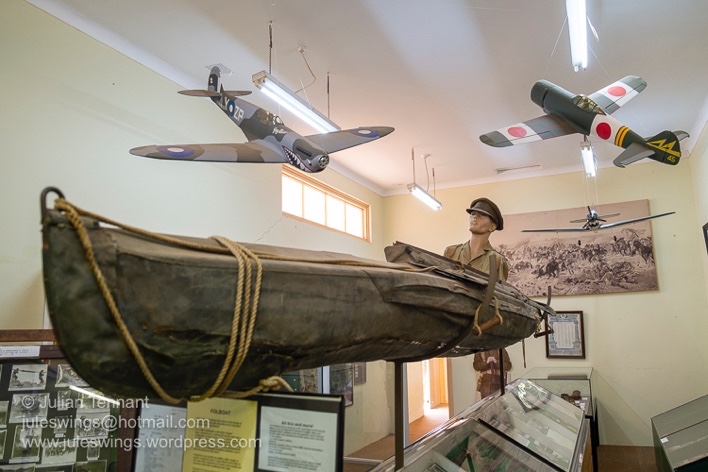
The ISD men kept quiet about their exploits for over 50 years, and even today, the full story has never really been made public. The whole story of ISD operations during WWII is one that has been largely overlooked and misunderstood for the past 75 years. One of the main reasons for this is the misunderstanding that ISD was named Z or M Special Unit. The Z and M just referred to their administrative arm of the units. Z Special Unit was also used for requisitioning stores and transport through Australian Army channels. There are cases where Colonels were removed from transport aircraft to make room for ISD Corporals. Such was the administrative power of the Z Special Unit. So, this is how it was broken down, for Australian Army personnel and civilians assigned to ISD, and later to SRD, and as such, Z Special Unit appears on the service records of every Australian soldier who was assigned to either of those organizations. Another reason for some of the confusion is that in early 1943 the SOA was giving a new code name the Services Reconnaissance Department (SRD), and the term SOA was only to be used at the highest level. Z Special Unit does not appear on the service records of RAAF, RAN or British, NZ, Canadian, or South African personnel assigned to ISD or SRD since they weren’t enlisted in the Australian Army. However, Z Special Unit or Z Force became a common term in the post-war years, even among SRD Veterans. Although it is historically inaccurate to refer to the Special Operations as Z Special Unit. So, where do M Special units fit in? During the war an Allied Special Forces Reconnaissance Team under the command of the Services Reconnaissance Department (SRD.) It was the successor of the Coastwatcher’s unit. Raised in Queensland, Australia, in 1943, the unit operated behind enemy lines for long periods in the Pacific theatre, collecting intelligence such as enemy troop movements and shipping details. It was disbanded at the end of the war in 1945.
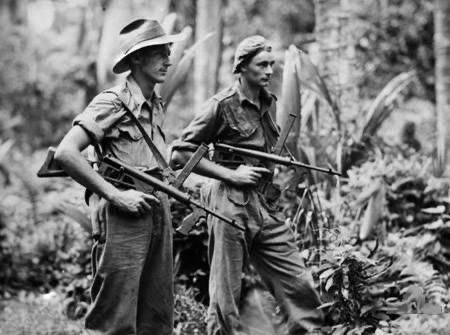
Unlike its sister unit, M Special Unit wasn’t as well known for direct action missions. Z Special Unit was comprised of about 81 members and generally inserted via small boat, submarine, or airplane and conducted quick hit and run missions. They would also conduct intelligence-gathering operations. M Special Unit, on the other hand, operated behind enemy lines for extended periods and did long-range intelligence collection; as such, they tried to go undetected and, as such rarely engage the enemy.
Also, all personal assigned to ISD were still listed as attached to the parent unit they came from. The reason for this was to help maintain secrecy. It was also used as a way to hide the funding for the ISD. As one of the best ways to keep something secret is never to show that money is going to them. The units never had an official insignia. You will often see a Z of M with a dagger through it. This was not made until 1970 and unfortunately, is mistaken for the units WWII symbol.
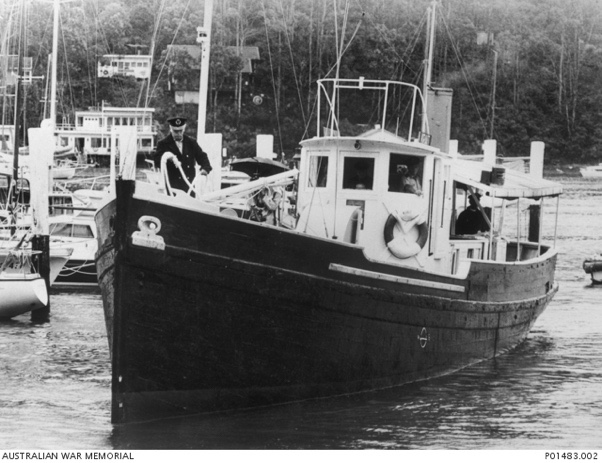
One of ISD/SRD’s most famous Operations was called Jaywick. They used a 68-ton wooden ship. British authorities had seized the Kofuku Maru in Singapore following Japan’s entry into the war. In 1943 she was renamed Krait and assigned to the SRD. The objective of Operation Jaywick was for SRD members to attack Japanese shipping in Singapore. SRD commandos paddled into Singapore harbor in kayaks and attached limpet mines to Japanese enemy shipping. The stealthy raiders sank seven ships and about 39,000 tons of supplies and equipment before escaping home to Australia. By the time they returned nearly seven weeks later, the crew of 14 had carried out one of the most successful clandestine raids in Australian history. Throughout the war, the 70-foot wooden-hulled boat involved in the Jaywick raid, MV Krait, sank more shipping than any other ship in the Australian navy.
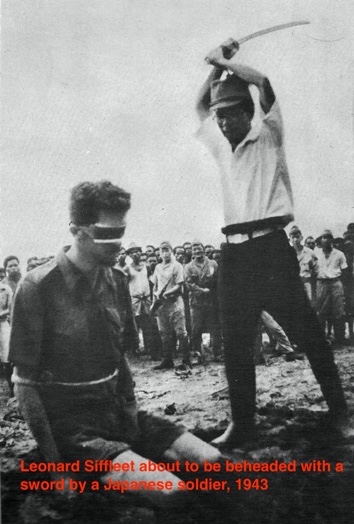
In a subsequent mission to Jaywick called Operation Rimau, the raiding party was detected by the enemy, hunted down and executed. Seventeen of SRD members lie in graves at Kranji War Cemetery in Singapore. In Operation Copper, eight men landed on an island off New Guinea to disable enemy guns before the Allied landing. Discovered by the Japanese, three commandos were captured, tortured, and executed. Four others escaped and fled out to sea, but only one made it home.
No matter what their name was or what they are called now, the units of WWII are the forefathers of today’s Special Forces in Australian and New Zealand and helped end the war.
www.australiansas.com/Establis%20SF
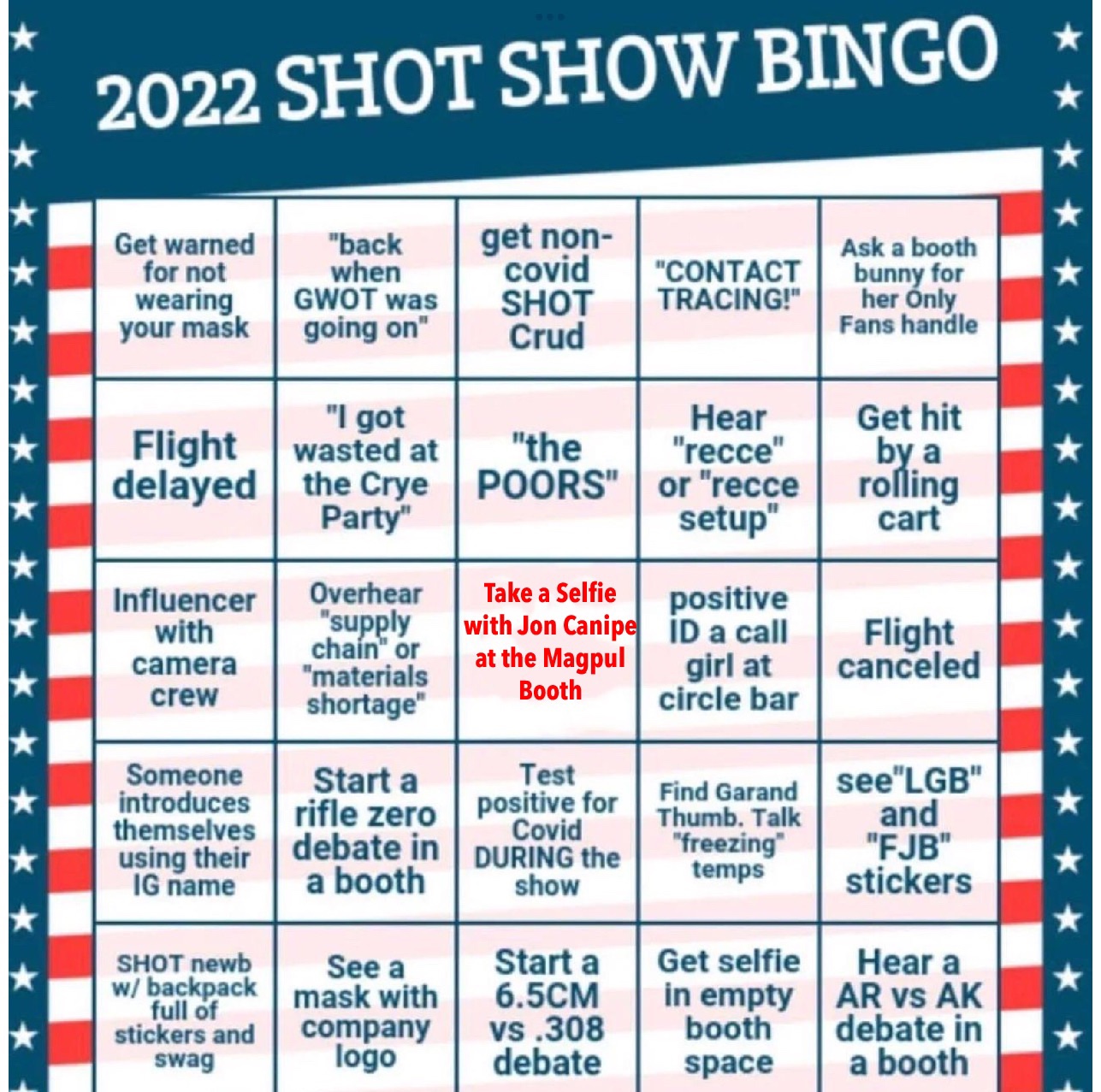
The NATO Support and Procurement Agency (NSPA) awarded the European leading robotics and autonomous systems (RAS) developer and system integrator Milrem Robotics a contract to provide RAS Concept Development and Experimentation (CD&E) Services to the Italian Army.

The scope of the multi-year campaign is to explore RAS technology in order to update the Italian army’s RAS strategy and outline an implementation roadmap for the introduction of unmanned systems and related technology into service.
Milrem Robotics will support the Italian army in developing a clear path to how RAS technology, systems and architectures can generate operational advantages and ground armed forces benefits when operating in urbanized environments.
“Milrem is proud to be selected as the partner for supporting the Italian Armed Forces in one of the most advanced and challenging RAS CD&E initiatives in the world. This program is well in line with our core competencies as a system integrator for autonomous and robotic technologies,” said Kuldar Väärsi, CEO of Milrem Robotics.
The Italian CD&E level of ambition is to exploit prototyping skills and technological capabilities to demonstrate future operational benefits and finally, to identify short to mid-term (5-15 years) transformational initiatives for the development of operational RAS capabilities.
The scope of the cooperation is to capture, analyse and deliver decision support data from all stages of the experimentation process, stemming from field activities, war-gaming, modelling and simulation, innovative technologies, etc., that will respond to the challenges set forth by the problem statement.
The deliverables of the contract include a Command and Control (C2) System, an autonomy engine, systems integration of 3rd party capabilities, several unmanned ground and air vehicles and a variety of sensors and effectors.
Milrem Robotics is the leading European robotics and autonomous systems developer and systems integrator. The company is known for its THeMIS and Multiscope Unmanned Ground Vehicles and the Type-X Robotic Combat Vehicle. The THeMIS supports dismounted troops while the Multiscope is intended for civilian use such as forestry and firefighting. The Type-X Robotic Combat Vehicle is a wingman for mechanized units.
Milrem Robotics is the leader of a consortium that was recently awarded 30.6M (EUR) from the European Commission’s European Defence Industrial Development Programme (EDIDP) to develop a European standardized unmanned ground system (UGS).
During the project, titled iMUGS, modular and scalable architecture for hybrid manned-unmanned systems will be developed to standardize a European wide ecosystem.
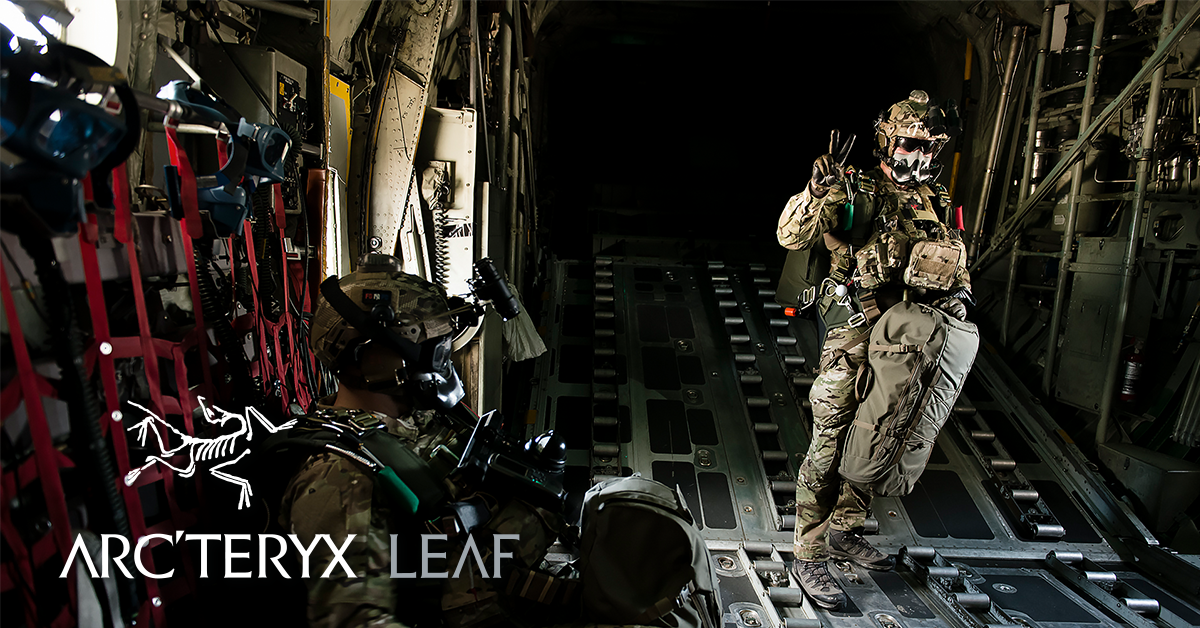
Arc’teryx LEAF will be exhibiting at the 2022 SHOT Show from a new location at the Caesars Forum. They’ll be showcasing their entire system-of-dress, purpose-built for the most demanding Special Forces and Tactical Law Enforcement end users. From Jan 18-20, LEAF will be having its customary Happy Hour starting 16:30hr. If you are around, drop by to say hello! They are at Booth #75417.
Essex Junction, Vermont (January 15, 2022) – Revision Military, the world leader in ballistic and laser protective eyewear systems, announces a new laser eye protection solution optimized for aviator protection and awareness. Developed with the Air Force Research Laboratory (AFRL), Revision’s CALI-C lens formulation offers eye protection that protects against common handheld laser hazards while performing in a cockpit environment.

Above: CALI-C is being offered in two configurations tailored for either fixed-wing or rotary-wing environments: The Aviator SF-2 frame (left) offers a lightweight metal frame with dual lenses – low profile and ideal for a fixed-wing cockpit. The StingerHawk® frame (right) offers a single wrap-around lens for maximum coverage, ballistic protection, and anti-fog performance for rotary-wing cockpits.
“Each year the FAA reports a higher rate of laser strikes against aircraft, putting aviators at risk,” said Revision CEO Amy Coyne. “Over the past decade, Revision has been partnered with AFRL on laser eye protection solutions for the military. This CALI-C formulation represents a real solution that gives aviators peace of mind while operating in low-altitude operations, keeping them safe and reducing the impact of laser hazards on their mission.”
The CALI (Commercial Aviation Low Intensity) solution was developed by AFRL in collaboration with Revision Military and successfully tested and evaluated by Washington State Patrol pilots. The Personnel Protection Team at AFRL’s Materials and Manufacturing Directorate is headed by Dr. Matthew Lange, who says “Simply put, the lenses maximize protection while minimizing the impact to the cockpit.”
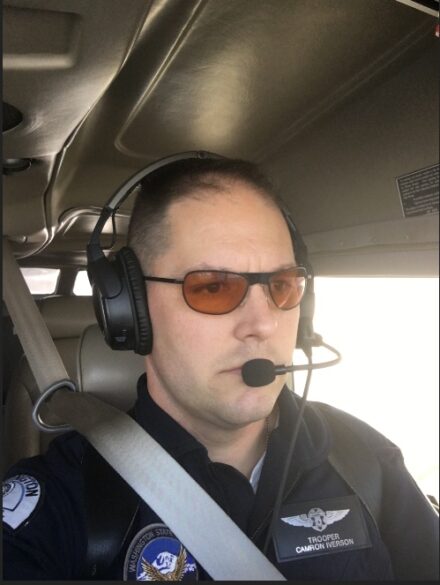
Above: Flight Officer Cameron Iverson of the Washington State Patrol tested CALI laser protective lenses formulated at Air Force Research Laboratory’s Materials and Manufacturing Directorate. (AFRL courtesy photo)
The ideal cockpit laser eye protection solution offers the following: a wide range of protection given the variety of laser hazards; lenses that don’t interfere with the cockpit instrument panel yet transmit enough light to be worn at night when most laser incidents occur; and are easy to don and doff featuring frames that integrate with cockpit head borne equipment (headsets, helmets, etc). Therefore, a set of laser protective eyewear designed for a ground-to-ground laser hazard isn’t ideal for the cockpit. The CALI-C solution was developed to maximize aviator protection and situational awareness – solving the challenges of laser eye protection in a cockpit environment.
Revision research scientists look to design formulations that consider the specific end-user environment and needs. Both rotary- and fixed-wing aircraft have the benefit of altitude, which means a reduction in the rate of eye damage, but a heightened threat of distraction, disorientation, and flash blindness as laser light can fill a cockpit with bright light in an instant. The CALI-C formulation takes this into account by offering a wide band of protection without compromising light transmission – a critical point given most aviation laser incidents happen at night.
CALI-C is being offered in two configurations tailored for either fixed-wing or rotary-wing environments: The Aviator SF-2 frame offers a lightweight metal frame with dual lenses – low profile and ideal for a fixed-wing cockpit. The StingerHawk® frame offers a single wrap-around lens for maximum coverage, ballistic protection, and anti-fog performance for rotary-wing cockpits. Both configurations of the CALI-C formulation are restricted for sale to aviation end users only. Please contact sales@revisionmilitary.com for more information. Additional background information about the laser hazards for aviation, and the development of the CALI-C product can be found here.
The all NEW AR-Takedown Tool is being released at Shot Show! 34.99 with free shipping! 100% USA made.

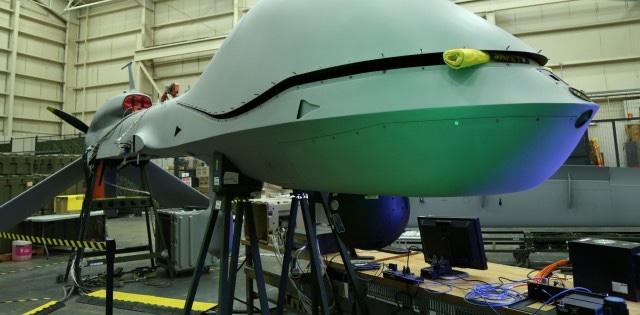
REDSTONE ARSENAL, Ala. — It’s more than just a buzzword — it’s the way of the future for Army aviation.
MOSA — modular open systems architecture (or approach) — has become a popular term in recent years in the defense community, but it’s something the U.S. Army Combat Capabilities Development Command Aviation & Missile Center’s Joint Technology Center/System Integration Laboratory has worked on for years. That expertise and baseline is helping the DEVCOM Aviation & Missile Center adapt technologies quickly, efficiently and at a lower cost to support Army modernization efforts.
“While it’s a new term today, for us it’s business as usual,” said Joe Reis, Multiple Unified Simulation Environment lead for the JSIL. “We’ve been striving for the last 10 years to try to break our software down into components so it can be reused. Wherever possible, we started adopting all these different standard protocols with the vision of being able to reuse those components and being able to integrate with more than just ourselves. With that we’re able to stretch into areas we never have before.”
At DEVCOM AvMC, the MOSA success story starts with MUSE — the Multiple Unified Simulation Environment — a command and staff trainer. Originally created to provide Intelligence, Surveillance and Reconnaissance simulation capabilities, today the government-developed and sustained MUSE software baseline is being used in a variety of systems, including advanced teaming, part of AvMC’s support to the Future Vertical Lift Cross-Functional Team. The JSIL works primarily with unmanned aircraft systems, to include Shadow, Gray Eagle, Reaper and Global Hawk.
“The MUSE baseline was the foundational software that we began with for the Advanced Teaming effort,” said JSIL Software Lead James Bowman III. “We’ve been modifying and enhancing the MUSE baseline for over 20 years, by incorporating customer capability requests, keeping pace with industry standards and maintaining an accreditation (Authority to Operate — ATO). It would not have been possible for the Army to constitute the capabilities inherent in MUSE in time to meet the needs of Army Futures Command.”
“We’ve leaped into this research and development field instead of just being a trainer, because of being able to break these components down,” Reis added.
For the AvMC team, that is the whole point of MOSA — delivering solutions expeditiously to the Army and the Warfighter.
“MOSA is taking a modular approach, and for us, that’s just not theoretical,” Bowman said. “Software modularity allows the teams to share components across our enterprise, thereby negating duplicative efforts. It is paramount that the government continue to address intelligent software design, since it is our responsibility to provide quality solutions to and for the Warfighter that are concurrently cost-optimal for the government.
“We work to ensure that there is an intentionality to identifying common capabilities, already resident in MUSE, in order to exploit for utilization in our UAS Trainer solutions. Obviously, if not properly implemented, there can be challenges with code synchronization. JSIL addresses this by adhering to industry standard software processes and by utilizing Azure DevOps to ensure solution integrity. Consequently, stove-pipe solutions are a thing of the past. Once a bug is fixed in a component, all software that utilizes that component inherits the benefits of the fix.”
Another MOSA success story is the JSIL’s support to the Synthetic Training Environment Cross-Functional Team. The Reconfigurable Virtual Collective Trainer-Air uses the MUSE baseline foundationally, merged with work the JSIL did for the Air Force, to create a UAS software baseline for the RVCT-A.
“We would not have been able to support the high op-tempo of the RVCT-A effort had we not leveraged and utilized this MOSA construct,” Bowman said. “We continue to be energized about the possibilities of utilizing the MUSE and collective decades of UAS modeling and simulation domain knowledge to address current and emerging requirements.”
What’s next for MOSA at AvMC? The JSIL team will support swarming unmanned aircraft systems, part of the work being done with Advanced Teaming and Air Launched Effects. That effort includes incorporating an Army Game Studio Image Generator, which will reduce the money spent for commercial off the shelf rendering engine licenses and maintenance fees, a price tag that runs over $1 million alone for one UAS variant.
“If we can take that million-dollar expenditure and invest it in an existing GOTS image generator, that cost just goes away,” Bowman said. “MOSA is not just some buzzword, in our view, the implementation thereof provides tangible evidence of how we save the Army money, and how we get solutions to the soldier expeditiously, because we’re constantly building on a pre-existing, well-vetted, foundation.”
AvMC supports a variety of partners with MOSA, to include Program Executive Office Aviation; PEO Simulation, Training and Instrumentation; the Air Force Agency for Modeling and Simulation; PEO Intelligence Electronic Warfare & Sensors; and the FVL and Synthetic Training Environment CFTs.
“All of this work that we have done and are very proud of also has a global impact,” Bowman said. “We work with coalition partners, and because we adhere to these standards, when we show up to an exercise, not only are we operating our simulation, our coalition partners ask us at times to help them and we do that proudly. We’re U.S. citizens working with our coalition partners that are going to go to battle with us in the event that hostilities break out. We’re very proud to work with these standards to support not just the U.S., but its partners.”
By Amy Tolson, DEVCOM Aviation & Missile Center Public Affairs